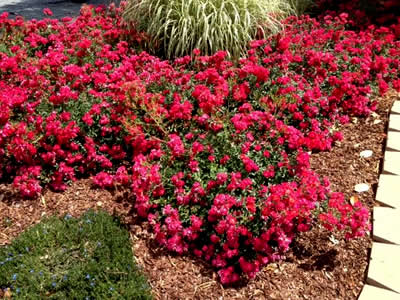Red Drift Rose |
|
|
Rosaceae Rosa Red Drift |
|
| Price |
|
| Availability and Options |
1 Gallon In StockOther Options: 
|
| Shipping Information |
Cannot ship to: Alaska, Hawaii
|
| Grows In | Zone 4A · -30° to -25° F through Zone 11 · Above 40° F Grows in Columbus! (Learn More) |
| Sun Exposure | Full / Mostly Sun, Morning Sun / Evening Shade |
| Soil Drainage | Well Drained |
| Resistent To | Drought, Insect, Disease, Mildew, Heat |
| Flower Color | Red |
| Blooms | Spring Blooms, Summer Blooms, Fall Blooms |
| Foliage Color | Dark Green |
| Average Height | 1' to 2' |
| Average Width | 2' to 3' |
| Attracts | Butterflies, Visual Attention |
Red Drift Rose is a fast growing shrub, groundcover plant and rose that can be grown in USDA Plant Hardiness Zones 4A through 11. It matures to an average height of 1 foot to 2 feet and an average width of 2 feet to 3 feet, depending on climate and other environmental factors. It prefers growing in a location that provides full sun or morning sun with afternoon shade and grows best when planted in sand, loam, clay or silt soil that is well drained. In the spring, summer and fall Red Drift Rose produces red flowers. The foliage is dark green in color. It attracts butterflies and visual attention and is resistant to drought, insects, diseases, mildew and heat.
Red Drift Rose can be useful in the landscape in mass plantings, in foundation plantings, in containers or planters, as a border or edger, in shrub borders, around decks, swimming pools, and other outdoor living areas, as a groundcover, in hanging baskets, in landscape beds or islands or to accentuate entryways and also in theme gardens, cottage gardens or perennial gardens.
 More about Red Drift Rose...
More about Red Drift Rose...Red Drift produces the smallest bloom of any of the roses in the Drift series. The gorgeous, fully double, deep-red, petite blooms appear in large clusters in spring, summer and fall. Red Drift has been one of the strongest performers of the series in our gardens.
The new family of Drift Roses are comparable to the family of Knock Out Roses in disease resistance and low-maintenance, however are much smaller in size. They get their small size from being a cross between full-size groundcover roses and miniature roses. From the former they kept toughness, disease resistance and winter hardiness. From the miniatures, they inherited their well-managed size and repeat-blooming nature.
The first colors introduced in the Drift series were Coral, Pink, Red, and Peach. But, now, Apricot (apricot shades, double blooms), Sweet (light pink, double blooms) and Icy (pure white, double blooms) have joined the family.
We've found that Drift roses have about five flower cycles yearly. The spring bloom in April and the fall bloom in October are the heaviest with sporadic lighter flowering between.
Drift Roses are are perfect in small gardens, splashing your landscapes with visual delight. Their smaller habit makes them perfect for use in containers or as a border or in small groups in garden and landscape beds.
When it comes to growing and caring for Drift Roses, bed preparation, irrigation and proper fertilization and pruning are the only keys to success. Full sun is best and at least 8 hours of sunlight is recommended. Morning sun is a must to dry dew from the leaves. We've seen powdery mildew appear on roses planted in morning shade.
PLANTING
Plant Drift Roses in well-prepared landscape beds that provide good drainage and a soil pH of 6.0 to 6.5 (mildly acidic). If your soil is heavy clay amend with a soil conditioner or compost.
We recommend spacing the plants a minimum of 3 feet apart, a distance in which they will eventually grow together to form a patch. If you would rather they be separated over the long term, plant them 5 to 6 feet apart, or more.
FEEDING
Fertilize Drift Roses with a slow- or timed-release fertilizer in spring for season-long feeding or with a mild, natural plant food in early spring, when new growth begins to emerge, and then after every flush of blooms throughout the season. Cease fertilization about two months before the first frost date.
Mulching your Drift roses keeps the feeder roots from drying out and helps to establish the roots more quickly. And you water less. Shredded wood mulch or pine straw are excellent mulches for roses.
PRUNING
Pruning Drift Roses is easy. Simply cut the plants back to about 6 inches above the ground in late winter, before new growth has begun to emerge. If you want, to keep plants tidy, you can remove spent flowers after each bloom cycle during the blooming season.
PROBLEMS
Drift Roses are highly disease-resistant so require no spraying. Blackspot and powdery mildew disease has been very minimal when planted where they will receive the morning sun.
In our gardens here in mid-Georgia these hardy groundcover roses have demonstrated themselves to be true, low-spreading, dwarf shrub roses. They have averaged 2-3 feet tall by 2-3 feet wide, some being a little smaller or larger, and are covered with blooms in spring and fall and sporadically between.